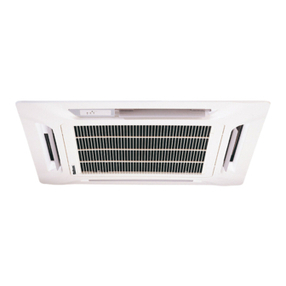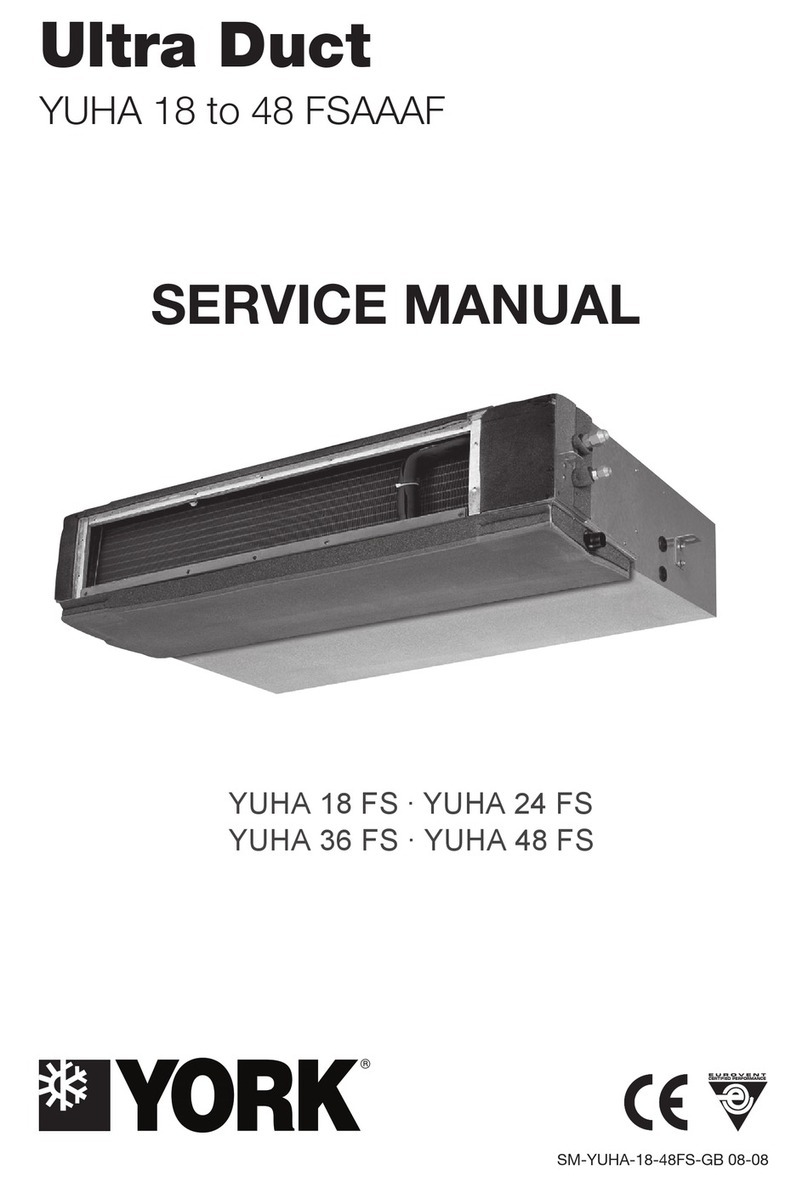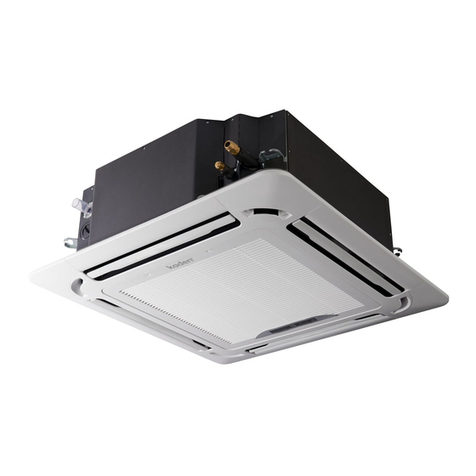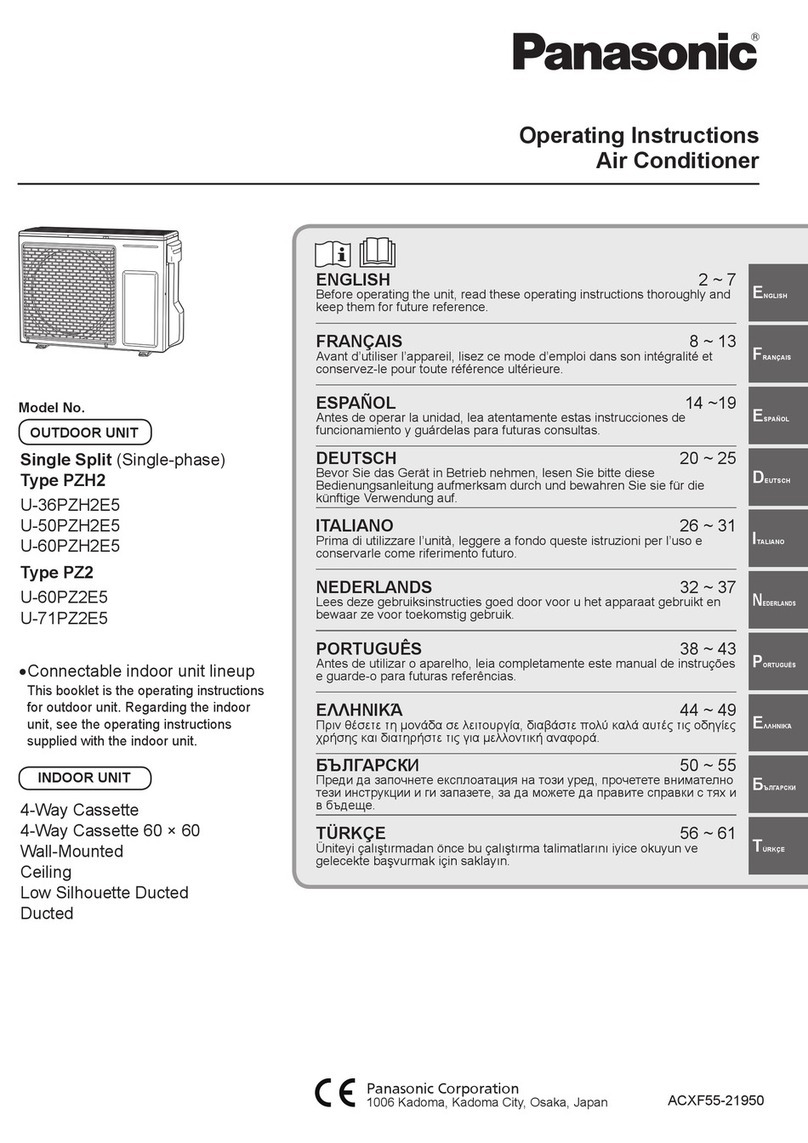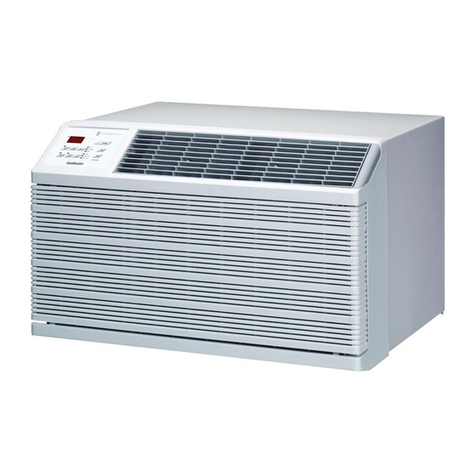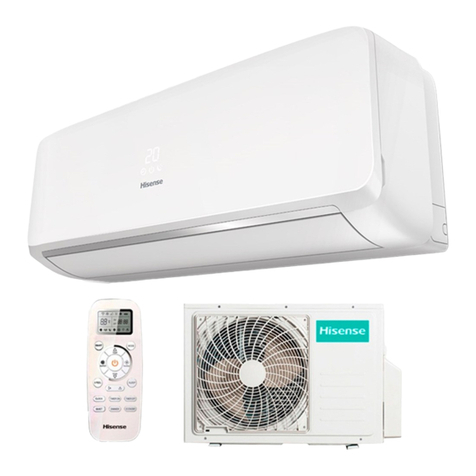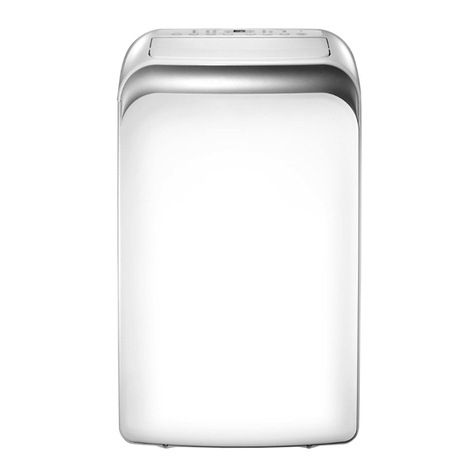LC COOK HLC-D User manual

1LC IO&M B51031-004
®
Receiving and Inspection
Carefully inspect the fan and accessories for any damage
and shortage immediately upon receipt of the fan.
• Turn the wheel by hand to ensure it turns freely and does
not bind
• Check dampers (if included) for free operation of all mov-
ing parts
• Record on the Delivery Receipt any visible sign of damage
Handling
Lift the fan by the base or the shipping carton.
NOTICE! Never lift by the shaft, motor or housing.
Storage
If the fan is stored for any length of time prior to installation,
completely ll the bearings with grease or moisture-inhibiting oil
(refer to Fan Bearing, page 4). Store the fan in its original crate
and protect it from dust, debris and weather.
• Cover the inlet, and outlet opening to prevent the accumula-
tion of dirt and moisture in the housing
• Periodically rotate the wheel and operate to keep a coating
of grease on all internal bearing parts
• Periodically inspect the unit to prevent damaging conditions
LC
Low Prole Roof Exhausters
INSTALLATION, OPERATION AND MAINTENANCE MANUAL
Rotating Parts & Electrical Shock Hazard:
Fans should be installed and serviced by qualied personnel
only.
Disconnect electric power before working on unit (prior to re-
moval of guards or entry into access doors).
Follow proper lockout/tagout procedures to ensure the unit
cannot be energized while being installed or serviced.
A disconnect switch should be placed near the fan in order
that the power can be swiftly cut o, in case of an emergency
and in order that maintenance personnel are provided com-
plete control of the power source.
Grounding is required. All eld-installed wiring must be com-
pleted by qualied personnel. All eld installed wiring must
comply with National Electric Code (NFPA 70) and all appli-
cable local codes.
Fans and blowers create pressure at the discharge and vac-
uum at the inlet. This may cause objects to get pulled into the
unit and objects to be propelled rapidly from the discharge.
The discharge should always be directed in a safe direction
and inlets should not be left unguarded. Any object pulled into
the inlet will become a projectile capable of causing serious
injury or death.
When air is allowed to move through a non-powered fan, the
impeller can rotate, which is referred to as windmilling. Wind-
milling will cause hazardous conditions due to unexpected ro-
tation of components. Impellers should be blocked in position
or air passages blocked to prevent draft when working on fans.
Friction and power loss inside rotating components will cause
them to be a potential burn hazard. All components should be
approached with caution and/or allowed to cool before con-
tacting them for maintenance.
Under certain lighting conditions, rotating components may
appear stationary. Components should be veried to be sta-
tionary in a safe manner, before they come into contact with
personnel, tools or clothing.
Failure to follow these instructions could result in death or se-
rious injury.
The attachment of roof mounted fans to the roof curb as well
as the attachment of roof curbs to the building structure must
exceed the structural requirements based on the environmen-
tal loading derived from the applicable building code for the
site. The local code ocial may require variations from the
recognized code based on local data. The licensed engineer
of record will be responsible for prescribing the correct attach-
ment based on construction materials, code requirements and
environmental eects specic to the installation.
This publication contains the installation, operation and
maintenance instructions for standard units of the LC (HLC-D,
HLC-B, TLC-D and TLC-B): Low Prole Roof Exhausters.
Carefully read this publication and any
supplemental documents prior to any
installation or maintenance procedure.
Loren Cook catalog, LC, provides additional information de-
scribing the equipment, fan performance, available accesso-
ries and specication data.
For additional safety information, refer to AMCA Publication
410-96, Safety Practices for Users and Installers of Industrial
and Commercial Fans.
All of the publications listed above can be obtained from:
• lorencook.com
• 417-869-6474 ext. 166
For information and instructions on special equipment, con-
tact Loren Cook Company at 417-869-6474.
HLC

2LC IO&M B51031-004
Figure 2 indicates where to measure
the allowable gap for the drive align-
ment tolerance. All contact points (in-
dicated by WXYZ) are to have a gap
less than the tolerance shown in the
table. When the pulleys are not the
same width, the allowable gap must
be adjusted by half of the dierence in
width. Figure 3 illustrates using a car-
penter’s square to adjust the position
of the motor pulley until the belt is par-
allel to the longer leg of the square.
Wiring Installation
Leave enough slack in the wiring to allow for motor move-
ment when adjusting belt tension. Some fractional motors
have to be removed in order to make the connection with the
terminal box at the end of the motor.
Refer to Wiring Diagrams, next page.
NOTICE! Follow the wiring diagram in the disconnect
switch and the wiring diagram provided with the mo-
tor. Correctly label the circuit on the main power box
and always identify a closed switch to promote safety
(i.e., red tape over a closed switch).
Fan Installation
The fan support (roof curb) should provide a level surface
for installation. If the roof is pitched more than 1/2:12, a sloped
curb must be used to correct for the incline. Place fan over
roof opening. Secure the fan with lag screws, anchor bolts or
other suitable fasteners.
For easier installation, larger size fans may be disassembled
on the ground and transported to the roof in sections. Howev-
er, if the sections are not assembled properly, the wheel may
rub against the fan inlet causing noise.
This can be prevented by:
• Ensuring the wheel is tightly fastened on the shaft.
• Ensuring the wheel is not dropped on the shaft before the
setscrews are tightened. Should interference occur, discon-
nect the power source. Refer to Bearing Replacement, page
5.
Final Installation Steps
1. Inspect fasteners and setscrews, particularly fan mount-
ing and bearing fasteners, and tighten according to the
recommended torque shown in the table, Recommended
Torque for Setscrews/Bolts, page 3.
2. Inspect for correct amperage and voltage with an amme-
ter and voltmeter.
3. Ensure all accessories are installed.
4. Inspect wheel-to-inlet clearance on power roof fans.
5. Test the fan to be sure the rotation is the same as indicat-
ed by the arrow marked Rotation.
NOTICE! Do not allow the fan to run in the wrong di-
rection. This will overheat the motor and cause seri-
ous damage. For 3-phase motors, if the fan is running
in the wrong direction, check the control switch. It is
possible to interchange two leads at this location so
that the fan is operating in the correct direction.
Installation
To prevent damage to the fan during shipping, motors 5 HP and
larger and extremely heavy motors (cast iron or severe duty) are
shipped loose and must be eld mounted by bolting the motor on the
motor mounting plate in the existing mounting slots.
Dampers
If your fan is supplied with dampers, follow the directions
below. If your fan does not include dampers, proceed to Belt
and Pulley Installation.
1. Place the damper inside the curb. Ensure the damper will
open freely for the correct direction of airow.
2. Secure to curb at the damper shelf.
3. Drill a hole in the curb shelf for conduit (needed for mo-
tor wiring).
4. Operate the dampers manually to ensure the blades move
freely. Dampers should be released from full open posi-
tion to check for proper closing.
5. Install fan over curb with the conduit location in line with
the conduit hole in the curb.
Belt and Pulley Installation
Belt tension is determined by the sound of the belts when
the fan is rst started. The belts will produce a loud squeal
which dissipates after the fan is operating at full capacity. If
belt tension is too tight or too loose, lost eciency and dam-
age can occur.
Do not change the pulley pitch diameter to change tension.
The change will result in a dierent fan speed.
1. Loosen the motor plate adjustment bolts on motor base
and move motor plate in order that the belts can easily slip
into the grooves on the pulleys. Never pry, roll, or force the
belts over the rim of the pulley.
2. Adjust the motor plate until proper tension is reached. For
proper tension, a deection of approximately 1/4” per foot
of center distance should be obtained by rmly pressing
the belt. Refer to Figure 1.
1 foot
1/4 inch
Figure 1
3. Lock the motor plate adjustment bolts in place.
4. Ensure pulleys are properly aligned. Refer to Figure 2.
Pulley Alignment
Pulley alignment is adjusted by loosening the motor pulley
setscrew and by moving the motor pulley on the motor shaft.
Figure 2
OFFSET ANGULAR OFFSET/ANGULAR
A
W
X
Y
Z
B
CENTER
DISTANCE
(CD)
GAP GAP
Tolerance
Center Distance Max.
Gap
Up through 12” 1/16”
12” up through 48” 1/8”
Over 48” 1/4”
Figure 3

3LC IO&M B51031-004
Wiring Diagrams
Vari-Flow Motors
For EC or VF see EC Motor Wiring supplement. For VF2 see PM
wiring supplement.
Single Speed, Single Phase Motor
T-
1
T-
4
Ground B
L2
L1
Ground A
Line
When ground is required, attach to ground A or B with No. 6 thread
forming screw. To reverse, interchange T-1 and T-4.
2 Speed, 2 Winding, Single Phase Motor
Ground A
Ground B
T-1
T-
4
Low Speed
High Speed
L1
L2
Line
When ground is required, attach to ground A or B with No. 6 thread
forming screw. To reverse, interchange T-1 and T-4 leads.
Single Speed, Single Phase, Dual Voltage
Ground B
J-10
T-5
Ground A
Link A
Link B
Low Voltage
Line
L2
L1
Ground A
Link A
and B
L1
L2
Line
Ground B
T-5
J-10
When ground is required, attach to ground A or B with No. 6 thread
forming screw. To reverse, interchange T-5 and J-10 leads.
3 Phase, 9 Lead Motor
456
1
7
2
8
3
9
L1L2L3
456
789
12 3
L1L2L3
Low Voltage
208/230 Volts
High Voltage
460 Volts
3 Phase, 9 Lead Motor
Y-Connection
7
1
6789
456
12 3
Low Voltage
208/230 V
olts
High V
oltage
460 Volts
8
2
4
9
3
5
L
1
L
3
L
2
L1L3
L2
3 Phase, 9 Lead Motor
Delta-Connection
To reverse, interchange any two line leads.
2 Speed, 1 Winding, 3 Phase Motor
Motor
1
2
3
4
5
6
Together
High Speed
Line
L1
L2
L
3
1
2
3
4
5
6
Open
Low Speed
Line
L1
L2
L3
Motor
To reverse, interchange any two line leads. Motors require magnetic
control.
2 Speed, 2 Winding, 3 Phase
L
1
T
1
T
2
T
3
Low Speed
Low Speed
Low Speed
High Speed
High Speed
High Speed
Motor
T
13
T
12
T
11
L
2
Line
L
3
To reverse:
High Speed - interchange leads T11 and T12.
Low Speed - interchange leads T1and T2.
Both Speeds - interchange any two line leads.
Typical Damper Motor Schematic
Fan
Motor
Damper
Motor*
Second
Damper
Motor
Tr
ansformer** Transformer*
*
L3
L2
L1
For 3-Phase, damper motor voltage should be the same between L1
and L2. For single phase application, disregard L3.
*Damper motors may be available in 115, 230 and 460 volt models.
The damper motor nameplate voltage should be veried prior to con-
nection.
**A transformer may be provided in some installations to correct the
damper motor voltage to the specied voltage.
Operation
Pre-Start Checks
1. Lock out all the primary and secondary power sources.
2. Inspect fasteners and setscrews, particularly those used
for mounting the fan, and tighten if necessary.
3. Inspect belt tension and pulley alignment. (Remember, if
belt tension is correct, a loud squeal occurs as the fan in-
creases to full power.)
4. Inspect motor wiring.
5. Ensure the belt touches only the pulleys.
6. Ensure fan and ductwork are clean and free of debris.
7. Test the fan to ensure the rotation of the wheel is the same
as indicated by the rotation label.
8. Restore power to unit.
Recommended Torque for Setscrews/Bolts (IN-LB)
Setscrews Hold Down Bolts
Size
Key Hex
Across
Flats
Recommended
Torque Size Recommended
Torque
Min. Max.
#8 5/64” 15 21 3/8”-16 324
#10 3/32” 27 33 1/2”-13 780
1/4 1/8” 70 80 5/8 ”-11 1440
5/16 5/32” 140 160 3/4”-10 2400
3/8 3/16” 250 290 7/8”-9 1920
7/16 7/32” 355 405 1”-8 2700
1/2 1/4” 560 640 1-1/8”-7 4200
5/8 5/16” 1120 1280 1-1/4”-7 6000
3/4 3/8” 1680 1920 - -
7/8 1/2” 4200 4800 - -
19/16” 5600 6400 - -

4LC IO&M B51031-004
Start Up
Turn on the fan. In variable speed units, set the fan to its
lowest speed. Inspect for the following:
• Direction of rotation
• Excessive vibration
• Unusual noise
• Bearing noise
• Improper belt alignment or tension (listen for a continuous squeal-
ing noise)
• Improper motor amperage or voltage
NOTICE! If a problem is discovered, immediately shut
o the fan. Lock out all electrical power and check for
the cause of the trouble. Refer to Troubleshooting.
Inspection
Inspection of the fan should be conducted at the rst 30
minute, 8 hour and 24 hour intervals of satisfactory opera-
tion. During the inspections, stop the fan and inspect as fol-
lows.
30 Minute Interval
Inspect bolts, setscrews and motor mounting bolts. Adjust
and tighten as necessary.
8 Hour Interval
Inspect belt alignment and tension. Adjust and tighten as
necessary.
24 Hour Interval
Inspect belt tension. Adjust and tighten as necessary.
Maintenance
Establish a schedule for inspecting all parts of the fan. The
frequency of inspection depends on the operating conditions
and location of the fan.
Inspect fans exhausting corrosive or contaminated air within
the rst month of operation. Fans exhausting contaminated air
(airborne abrasives) should be inspected every three months.
Clean the wheel and air inlets if material build-up is exces-
sive. Excessive build-up can cause imbalance and failure of
the wheel.
Regular inspections are recommended for fans exhausting
non-contaminated air.
It is recommended the following inspections be con-
ducted twice per year.
• Inspect bolts and setscrews for tightness. Tighten as necessary.
• Inspect belt wear and alignment. Replace worn belts with new belts
and adjust alignment as needed. See Belt and Pulley Installation,
page 2
• Bearings should be inspected as recommended in the Conditions
Chart
• Inspect for cleanliness. Clean exterior surfaces only. Removing
dust and grease on motor housing assures proper motor cooling
Conditions Chart
RPM Temp °F Greasing Interval
Up to 1000 -30 to 120 3 months
120 to 200 1 month
1000 to 3000 -30 to 120 6 weeks
120 to 200 2 weeks
Over 3000 -30 to 120 2 weeks
120 to 200 1 week
Any Speed < -30 Consult Factory
Any Speed > 200 1/2 week
For moist or otherwise contaminated installations, divide the
interval by a factor of three.
Fan Bearings
The fan bearings are provided prelubricated. Any special-
ized lubrication instructions on fan labels supersedes informa-
tion provided herein. Bearing grease is a petroleum lubricant
in a lithium base conforming to an NLGI #2 consistency. If
user desires to utilize another type of lubricant, they take re-
sponsibility for ushing bearings and lines and maintaining a
lubricant that is compatible with the installation.
An NLGI #2 grease is a light viscosity, low-torque, rust-in-
hibiting lubricant that is water resistant. Its temperature range
is from -30°F to 200°F and capable of intermittent highs of
250° F.
Bearings should be relubricated in accordance with the Re-
lubrication Intervals chart, below.
For best results, lubricate the bearing while the fan is in
operation. Pump grease in slowly until a slight bead forms
around the bearing seals. Excessive grease can damage seal
and reduce life through excess contamination and/or loss of
lubricant.
In the event that the bearing cannot be seen, use no more
than three injections with a hand operated grease gun.
Motor Bearings
Motors are provided with prelubricated bearings. Any lubri-
cation instructions shown on the motor nameplate supersede
instructions below.
Direct Drive 1050/1075, 1200, 1300 and 1500 RPM units
use a prelubricated sleeve bearing that has an oil-saturated
wicking material surrounding it. The initial factory lubrication
is adequate for up to 10 years of operation under normal con-
ditions. However, it is advisable to add lubricant after three
years. Use only LIGHT grade mineral oil or SAE 10W oil up
to 30 drops. If the unit has been stored for a year or more, it
is advisable to lubricate as directed above. For direct drive
units and other units in severe conditions, lubrication intervals
should be reduced to half.
Motors without sleeve bearings (as described above) will
have grease lubricated ball or roller bearings. Motor bearings
without provisions for relubrication will operate up to 10 years
under normal conditions with no maintenance. In severe ap-
plications, high temperatures or excessive contaminates, it is
advisable to have the maintenance department disassemble
and lubricate the bearings after three years of operation to
prevent interruption of service.
For motors with provisions for relubrication, follow intervals
of the table below.
Relubrication Intervals
Service
Conditions
NEMA Frame Size
Up to & including
184T 213T-365T 404T & larger
1800
RPM and
less
Over
1800
RPM
1800
RPM and
less
Over
1800
RPM
1800
RPM and
less
Over
1800
RPM
Standard 3 years 6 months 2 years 6 months 1 year 3 months
Severe 1 year 3 months 1 year 3 months 6 months 1 month
Motors are provided with a polyurea mineral oil NGLI #2
grease. All additions to the motor bearings are to be with
a compatible grease such as Exxon Mobil Polyrex EM and
Chevron SRI.
The above intervals should be reduced to half for vertical
shaft installations.

5LC IO&M B51031-004
Motor Services
Should the motor prove defective within a one-year period,
contact your local Loren Cook representative or your nearest
authorized electric motor service representative.
Changing Shaft Speed
All belt driven fans with motors up to and including 5HP are
equipped with variable pitch pulleys. To change the fan speed,
perform the following:
1. Loosen setscrew on driver (motor) pulley and remove key,
if equipped.
2. Turn the pulley rim to open or close the groove facing. If
the pulley has multiple grooves, all must be adjusted to
the same width.
3. After adjustment, inspect for proper belt tension.
Speed Reduction
Open the pulley in order that the belt rides deeper in the
groove (smaller pitch diameter).
Speed Increase
Close the pulley in order that the belt rides higher in the
groove (larger pitch diameter). Ensure that the RPM limits of
the fan and the horsepower limits of the motor are maintained.
Maximum RPM
HLC-B
Size
Maximum RPM
Standard Reinforced
100 1740 -
120 1695 -
135 1780 -
150 1620 -
165 1335 -
180 1555 -
195 1345 -
210 1245 1345
225 1140 118 5
245 1010 -
270 875 -
300 825 985
330 605 865
365 615 705
402 535 615
445 445 510
490 390 430
540 345 415
TLC-B
Size
Maximum RPM
Standard Reinforced
100 1755 -
120 1730 -
135 1750 -
150 1640 -
165 1325 -
180 1490 -
195 1325 -
210 1275 1325
225 1135 1180
245 1015 -
270 865 -
300 830 995
330 700 880
365 610 725
402 535 610
445 455 520
490 390 430
540 345 415
Pulley and Belt Replacement
1. Clean the motor and fan shafts.
2. Loosen the motor plate mounting bolts to relieve the belt
tension. Remove the belts.
3. Loosen the pulley setscrews and remove the pulleys from
the shaft.
• If excessive force is required to remove the pulleys, a three-
jaw puller can be used. This tool, however, can easily warp
a pulley. If the puller is used, inspect the trueness of the pul-
ley after it is removed from the shaft. The pulley will need re-
placement if it is more than 0.020” out of true.
4. Clean the bores of the pulleys and place a light coat of oil
on the bores.
5. Remove grease, rust and burrs from the shaft.
6. Place fan pulley on the fan shaft and the motor pulley on
the motor shaft. Damage to the pulleys can occur when
excessive force is used in placing the pulleys on their re-
spective shafts.
7. After the pulleys have been correctly placed back onto
their shafts, tighten the pulley setscrews.
8. Install the belts on the pulleys. Align and adjust the belts
to the proper tension as described in Belt and Pulley In-
stallation, page 2.
Bearing Replacement
The fan bearings are pillow block ball bearings.
1. Loosen screws on bearing cover.
2. Push bearing cover toward the wheel. As the bearing cov-
er moves toward the wheel, it will slide down to reveal the
bearings and shaft.
3. Remove the old bearing.
4. Remove any burrs from the shaft by sanding.
5. Slide new bearings onto the shaft to the desired location
and loosely mount bearings onto the bearing support.
Bearing bolts and setscrews should be loose enough to
allow shaft positioning.
6. Correctly position the wheel and tighten the bearing bolts
securely to the bearing support.
7. Align setscrews bearing to bearing and secure tightly to
the shaft.
NOTICE! Never tighten both pairs of setscrews before
securing bearing mounting bolts. This may damage
the shaft.
8. Inspect the wheel position again. If necessary, re-adjust
by loosening the bearing bolts and setscrews and repeat
from step 5.
Wheel Replacement
1. Drill two holes approximately centered between the shaft
and the edge of the hub OD with the following dimensions:
• 1/4” diameter
• 3/8” to 1/2” deep
• 180° apart in face of hub
2. Tap 1/4” holes to 5/16” thread with the 5/16” hole tap. Do
not drill or tap any larger than recommended.
3. Screw the puller arms into the tapped holes full depth of
threads (3/8” to 1/2” approximately). Align center of pull-
er with center of shaft. Make certain all setscrews in hub
(normally a quantity of two) are fully removed. Work puller
slowly to back wheel o the shaft.
Recommended Puller
Lisle No. 45000 Steering Wheel Puller. This puller is avail-
able at most automotive parts retail outlets.
Wheel PullerDrilled Hole Location
Wheel-to-Inlet Clearance
The correct wheel-to-inlet clearance is critical to proper fan
performance. This clearance should be veried before initial
start-up since rough handling during shipment could cause a
shift in fan components. Refer to wheel/inlet drawing below for
correct overlap.
Adjust the overlap by loosening the wheel hub and moving
the wheel along the shaft to obtain the correct value.

6LC IO&M B51031-004
Wheel/Inlet Overlap
Size Overlap
100–165 3/16”
180–245 1/4”
270–300 5/16”
330–365 3/8”
402 7/16”
445–490 1/2”
540 13/16”
OVERLAP
RADIAL
CLEARANCE
WHEEL SHROUD
INLET
Troubleshooting
Problem and Potential Cause
Low Capacity or Pressure:
• Incorrect direction of rotation. Make sure the fan rotates
in same direction as the arrows on the motor or belt drive
assembly
• Poor fan inlet conditions. There should be a straight clear
duct at the inlet
• Improper wheel alignment
Excessive Vibration and Noise:
• Damaged or unbalanced wheel
• Belts too loose; worn or oily belts
• Speed too high
• Incorrect direction of rotation. Make sure the fan rotates
in same direction as the arrows on the motor or belt drive
assembly
• Bearings need lubrication or replacement
• Fan surge
Overheated Motor:
• Motor improperly wired
• Incorrect direction of rotation. Make sure the fan rotates
in same direction as the arrows on the motor or belt drive
assembly
• Cooling air diverted or blocked
• Improper inlet clearance
• Incorrect fan RPMs
• Incorrect Voltage
Overheated Bearings:
• Improper bearing lubrication
• Excessive belt tension

7LC IO&M B51031-004
HLC-B
1
2
3
4
5
6
7
8
9
10
11
12
13
14
15
16
17
18
19
20
Si
ze 270–540 Shown
Part No. Description
Sizes 100–245 Sizes 270–540
1Hinge Bar Hinge Bar
2Bearing Plate Bearing Plate
3Wheel Assembly Wheel Assembly
4Bearing (2) Bearing (2)
5Motor Plate Motor Plate
6Motor Motor
7Shaft Shaft
8Mounting Rail (2) Mounting Rail (2)
9-Isolator Bracket (4)
10 Isolator (4) Isolator (4)
11 Support Post (4) Support Post (4)
12 Wrapper (4) Wrapper (4)
13 Base Base
14 Hood Assembly Hood Assembly
15 Hood Support (2) Hood Support (2)
16 Driver Sheave Driver Sheave
17 Birdscreen Assembly Birdscreen Assembly
18 Belt Set Belt Set
19 Driven Sheave Driven Sheave
20 Power Assembly Rail (2) Power Assembly Rail (2)
Parts List
HLC-D
1
2
4
5
6
7
8
9
10
11
12
3
Part No. Description (Sizes 100–180)
1Hinge Bar
2Wheel Assembly
3 Hood Support (2)
4Motor
5Isolators (4)
6Mounting Rail (2)
7Support Post (4)
8Base
9Hood Assembly
10 Motor Plate
11 Birdscreen Assembly
12 Power Assembly Rail (2)

8LC IO&M B51031-004
Limited Warranty
Loren Cook Company warrants that your Loren Cook fan was manufactured free of defects in materials and workmanship, to the extent stated herein. For a
period of one (1) year after date of shipment, we will replace any parts found to be defective without charge, except for shipping costs which will be paid by you.
This warranty is granted only to the original purchaser placing the fan in service. This warranty is void if the fan or any part thereof has been altered or modied
from its original design or has been abused, misused, damaged or is in worn condition or if the fan has been used other than for the uses described in the com-
pany manual. This warranty does not cover defects resulting from normal wear and tear. To make a warranty claim, notify Loren Cook Company, General Oces,
2015 East Dale Street, Springeld, Missouri 65803-4637, explaining in writing, in detail, your complaint and referring to the specic model and serial numbers of
your fan. Upon receipt by Loren Cook Company of your written complaint, you will be notied, within thirty (30) days of our receipt of your complaint, in writing, as
to the manner in which your claim will be handled. If you are entitled to warranty relief, a warranty adjustment will be completed within sixty (60) business days of
the receipt of your written complaint by Loren Cook Company. This warranty gives only the original purchaser placing the fan in service specically the right. You
may have other legal rights which vary from state to state. For fans provided with motors, the motor manufacturer warrants motors for a designated period stated
in the manufacturer’s warranty. Warranty periods vary from manufacturer to manufacturer. Should motors furnished by Loren Cook Company prove defective dur-
ing the designated period, they should be returned to the nearest authorized motor service station. Loren Cook Company will not be responsible for any removal
or installation costs.
Corporate Oces: 2015 E. Dale St. Springeld, MO 65803
Phone 417-869-6474 | Fax 417-862-3820 | lorencook.com
September 2020
TLC-B
1
2
3
4
5
6
7
8
9
10
11
13
14
15
16
17
18
12
19
Size 100–245 Shown
Part No. Description (Sizes 100–180)
Sizes 100–245 Sizes 270–540
1Bearing Plate Bearing Plate
2Wheel Assembly Wheel Assembly
3Bearings (2) Bearings (2)
4Motor Plate Motor Plate
5Motor Motor
6Shaft Shaft
7Isolator (4) Isolator (4)
8-Isolator Bracket (4)
9Support Post (4) Support Post (4)
10 Wrapper (4) Wrapper (4)
11 Base Base
12 Hood Support (2) Hood Support (2)
13 Penthouse Assembly Penthouse Assembly
14 Mounting Rail (2) Mounting Rail (2)
15 Driver Sheave Driver Sheave
16 Belt Set Belt Set
17 Driven Sheave Driven Sheave
18 Birdscreen Assembly Birdscreen Assembly
19 Power Assembly Rail (2) Power Assembly Rail (2)
Parts List
TLC-D
1
2
3
4
5
6
7
8
9
10
11
Part No. Description (Sizes 100–180)
1Wheel Assembly
2Birdscreen Assembly
3Motor
4Isolator (4)
5Mounting Rail (2)
6Support Post (4)
7Base
8Hood Support (2)
9Penthouse Assembly
10 Motor Plate
11 Power Assembly Rail (2)
This manual suits for next models
3
Table of contents
Popular Air Conditioner manuals by other brands

Carrier
Carrier Fan Coil 42B Installation, operation and maintenance manual

Frigidaire
Frigidaire FAC064K7A2 Factory parts catalog

Friedrich
Friedrich ZoneAire Compact P08SA owner's manual

LG
LG L5UC728FA0 installation manual
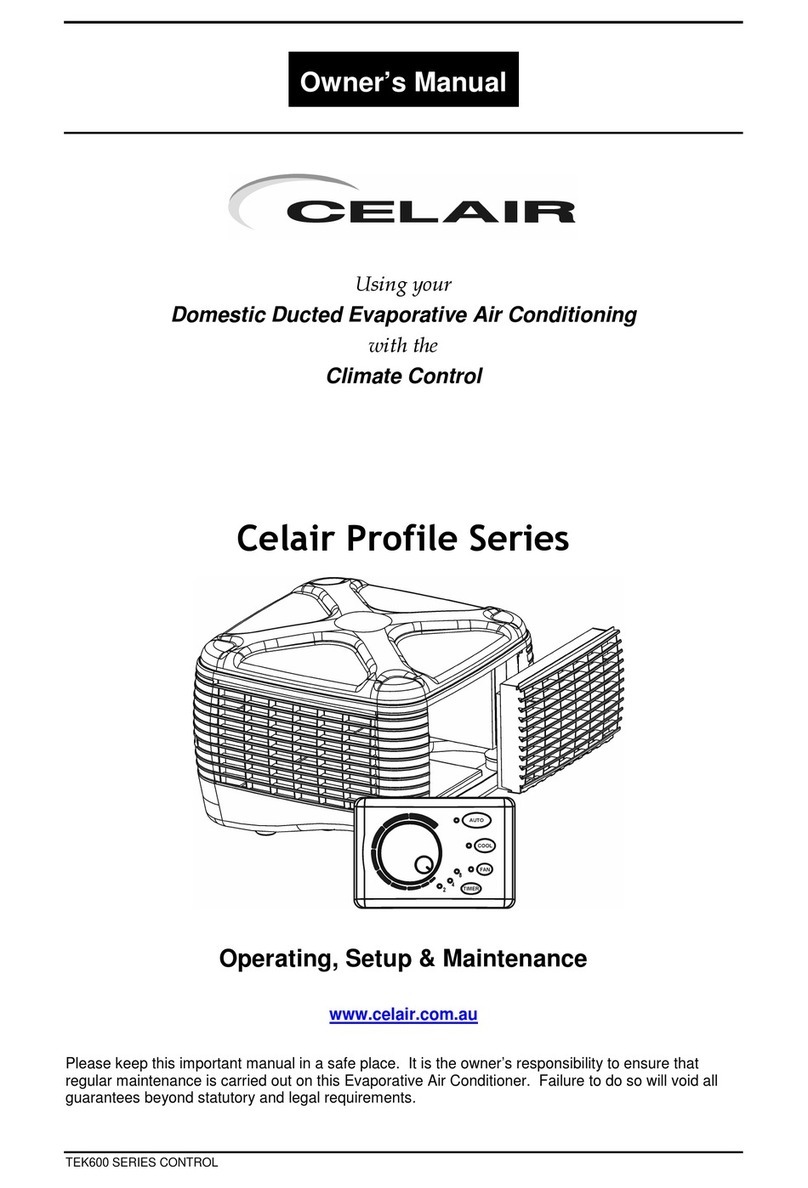
Celair
Celair Profile Series owner's manual

Mitsubishi Electric
Mitsubishi Electric MSZ-LN18VG2W operating instructions
